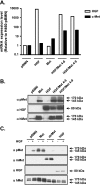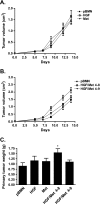Co-overexpression of Met and hepatocyte growth factor promotes systemic metastasis in NCI-H460 non-small cell lung carcinoma cells
- PMID: 20019837
- PMCID: PMC2794510
- DOI: 10.1593/neo.09622
Co-overexpression of Met and hepatocyte growth factor promotes systemic metastasis in NCI-H460 non-small cell lung carcinoma cells
Abstract
Complete resection of early-stage non-small cell lung cancer (NSCLC) is potentially curative, yet approximately 50% of patients are at risk for developing metastatic recurrence. Met, the receptor for hepatocyte growth factor (HGF) is a receptor tyrosine kinase with demonstrated roles in regulating cellular proliferation, motility, morphogenesis, and apoptosis. Met receptor and its ligand, HGF, are commonly overexpressed in NSCLC, and their overexpression has been associated with poor prognosis, which could potentially involve a paracrine and/or autocrine activation loop. However, there is as yet no direct evidence that HGF-Met signaling directly promotes metastasis in NSCLC cells. Using retroviral transduction, we overexpressed the human c-met and hgf complementary DNA, alone or in combination in the NCI-H460 human large cell carcinoma cell line. The HGF/Met co-overexpressing (H460-HGF/Met) cells demonstrated enhanced tumorigenicity in xenograft SCID mice. When these cells are implanted orthotopically into the lungs of nude rats, only the H460-HGF/Met cells showed higher spontaneous metastases to distant organs including bone, brain, and kidney. These results provide evidence that autocrine overactivation of the Met- HGF loop enhances systemic metastases in NSCLC. Targeted interference of this loop may potentially be an effective adjuvant therapy to improve survival of early-stage NSCLC patients.
Figures





Similar articles
-
L1 cell adhesion molecule promotes tumorigenicity and metastatic potential in non-small cell lung cancer.Clin Cancer Res. 2012 Apr 1;18(7):1914-24. doi: 10.1158/1078-0432.CCR-11-2893. Epub 2012 Feb 3. Clin Cancer Res. 2012. PMID: 22307136
-
New metastatic model of human small-cell lung cancer by orthotopic transplantation in mice.Cancer Sci. 2015 Apr;106(4):367-74. doi: 10.1111/cas.12624. Epub 2015 Feb 26. Cancer Sci. 2015. PMID: 25640943 Free PMC article.
-
Activation of hepatocyte growth factor-met autocrine loop enhances tumorigenicity in a human lung adenocarcinoma cell line.Neoplasia. 2000 May-Jun;2(3):226-34. doi: 10.1038/sj.neo.7900080. Neoplasia. 2000. PMID: 10935508 Free PMC article.
-
MET as a possible target for non-small-cell lung cancer.J Clin Oncol. 2013 Mar 10;31(8):1089-96. doi: 10.1200/JCO.2012.43.9422. Epub 2013 Feb 11. J Clin Oncol. 2013. PMID: 23401458 Free PMC article. Review.
-
Unveiling the Role of HGF/c-Met Signaling in Non-Small Cell Lung Cancer Tumor Microenvironment.Int J Mol Sci. 2024 Aug 22;25(16):9101. doi: 10.3390/ijms25169101. Int J Mol Sci. 2024. PMID: 39201787 Free PMC article. Review.
Cited by
-
The origin of brain malignancies at the blood-brain barrier.Cell Mol Life Sci. 2023 Sep 9;80(10):282. doi: 10.1007/s00018-023-04934-1. Cell Mol Life Sci. 2023. PMID: 37688612 Free PMC article. Review.
-
Characterization of evolution trajectory and immune profiling of brain metastasis in lung adenocarcinoma.NPJ Precis Oncol. 2021 Feb 12;5(1):6. doi: 10.1038/s41698-021-00151-w. NPJ Precis Oncol. 2021. PMID: 33580130 Free PMC article.
-
Impact of tumor blood flow modulation on tumor sensitivity to the bioreductive drug banoxantrone.J Pharmacol Exp Ther. 2013 Feb;344(2):368-77. doi: 10.1124/jpet.112.200089. Epub 2012 Nov 28. J Pharmacol Exp Ther. 2013. PMID: 23192656 Free PMC article.
-
Predictive and Prognostic Biomarkers for Lung Cancer Bone Metastasis and Their Therapeutic Value.Front Oncol. 2021 Oct 14;11:692788. doi: 10.3389/fonc.2021.692788. eCollection 2021. Front Oncol. 2021. PMID: 34722241 Free PMC article. Review.
-
Microvesicles derived from human Wharton's jelly mesenchymal stem cells promote human renal cancer cell growth and aggressiveness through induction of hepatocyte growth factor.PLoS One. 2014 May 5;9(5):e96836. doi: 10.1371/journal.pone.0096836. eCollection 2014. PLoS One. 2014. PMID: 24797571 Free PMC article.
References
-
- Richardson GE, Johnson BE. The biology of lung cancer. Semin Oncol. 1993;20:105–127. - PubMed
-
- Kalemkerian GP. Biology of lung cancer. Curr Opin Oncol. 1994;6:147–155. - PubMed
-
- Gazdar AF. Cell biology and molecular biology of small cell and non-small cell lung cancer. Curr Opin Oncol. 1990;2:321–327. - PubMed
-
- Cooper CS, Park M, Blair DG, Tainsky MA, Huebner K, Croce CM, Vande Woude GF. Molecular cloning of a new transforming gene from a chemically transformed human cell line. Nature. 1984;311:29–33. - PubMed
-
- Bottaro DP, Rubin JS, Faletto DL, Chan AM, Kmiecik TE, Vande Woude GF, Aaronson SA. Identification of the hepatocyte growth factor receptor as the c-met proto-oncogene product. Science. 1991;251:802–804. - PubMed
Publication types
MeSH terms
Substances
Grants and funding
LinkOut - more resources
Full Text Sources
Other Literature Sources
Medical
Miscellaneous
